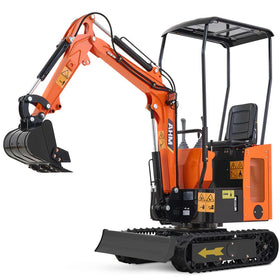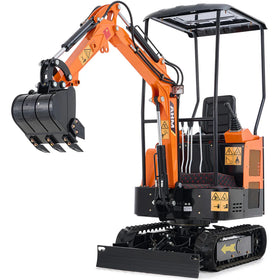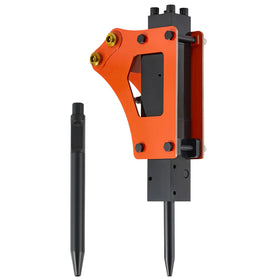Mini excavators can do almost any type of work that standard-sized excavators can, but they also have one advantage. These compact machines are perfect for tight spaces or spaces where you need to maneuver easily. You can also use various attachments on them, the most popular choice being a mini-excavator bucket.
But did you know that there are several different mini-excavator bucket types? Yes, there are several options you can choose from when buying a mini-excavator bucket, so let’s take a closer look at some of them!

Mini-Excavator Bucket Types
If you are unsure which bucket type would be perfect for you, you have a more detailed description of several of the most common types down below:
1. V Ditch Bucket For Mini Excavator
Also known as a V-bucket, this type of bucket is particularly useful when you want to dig V-shaped ditches and trenches. Some of the most common uses of V-bucket include digging irrigation and drainage ditches, utility (for pipes and cables) ditches, and roadside drainage ditches.
These buckets are popular because they save time and due to their versatility. However, they also produce a minimal amount of backfill, which means you won’t have to spend much time backfilling after the digging part is over. Digging V-shaped trenches is also safer, as it reduces the possibility of soil collapse.
2. Grading Bucket For Mini Excavator
Grading buckets have wide and flat bottoms, which makes them perfect for grading and leveling loose soil, sand, gravel, and similar materials. They are used during the finishing work when you want to make everything smooth and even. Of course, you can also use them to move the soil, sand, or gravel that you plan to grade.
These buckets are also perfect when you want to reduce ground disturbance and keep the integrity of the surface. Projects that require the use of grading buckets are landscaping, foundation preparation, roadside work, building the driveways, and cleaning up the construction site.
3. Tilt Bucket For Mini Excavator
Sometimes, you might need the bucket on your excavator to work under an awkward angle. That’s when you need to get a tilt bucket - a bucket type that can tilt and rotate all 360 degrees. With this type of bucket, you can reach even the most awkward angles with ease.
This might come in handy during projects such as foundation work, landscaping, roadwork, bridge construction, utility installation, and demolition work. The flexibility of tilt buckets also means that you will have to make less movements and adjustments with the mini-excavator, which can also come in handy in certain situations.
4. Trenching Bucket For Mini Excavator

In case you want to dig narrow but deep and long trenches, a trenching bucket is your go-to choice. Some trenching buckets even come with side cutters, which allows you to dig even more precisely. Additionally, trenching buckets have a curved shape that allows them to scoop out the soil while digging, leaving a clean and ready-to-use trench.
Projects that might require a trenching bucket include irrigation, drainage, landscaping, utility installation, and footing excavation. Basically, you can use a trenching bucket for any project that requires you to dig narrow but deep trenches with a lots of precision.
5. Rock Bucket For Mini Excavator
Are you working on a rocky terrain? Then, the regular mini-excavator buckets might not be strong and durable enough. That’s where the rock bucket comes into play - this bucket has reinforced tines that allow you to grab rocks while letting the soil pass through.
As such, rock buckets are perfect for projects such as demolition, land clearing, construction work, landscaping, and roadwork. Basically, use rock buckets for more demanding projects, especially if you need to work with large rocks, building debris, and other heavy objects.
Honorable Mentions

Apart from the above-listed bucket types, here are some other options that might be useful and interesting to you:
- Skeleton buckets - they have gaps between tines, which allow you to sift through different materials or types of debris and sort them
- Hardpan buckets - they are used to break through frosted or otherwise hard soil and similar surfaces
- High-capacity buckets - they are designed to carry bulky and voluminous materials, such as snow, tree branches, loose gravel, etc.
- Mud buckets - used to move soft materials, such as clay and mud. Great for work in muddy areas.
Which Mini-Excavator Bucket Should You Choose?
Now that you know everything about different buckets, the question arises: which one should you choose for your next project? Obviously, the main criterion is the nature of your project. Do you need this bucket to dig holes or to carry various materials? It wouldn’t make much sense if you used V-bucket to do some grading.
Apart from choosing the right type of bucket that will correspond to the type of work that you’re doing, there are also some other things to consider. For example, your mini-excavator should be able to connect to that type of bucket. That’s why you should use mini-excavators that are compatible with different bucket types:
13.5 HP 1 Ton B&S Engine Mini Excavator with 2600 lbf Digging Force
This excavator is small and capable of fitting and working even in the tightest places. However, don’t let its size fool you: it is still a powerful machine with a digging force of 2600 lbf. It can also connect and work with various attachments, including different bucket types.

13.5 HP B&S Engine Mini Excavator with Enclosed Cab
If you want the security and the comfort of an enclosed cabin, then you should take a look at this mini-excavator instead. It is also great for working in narrow spaces, as well as on challenging terrains. With this mini-excavator, you can use various attachments, including many different bucket types.
Conclusion
Just when you think you have everything you need for your mini-excavator, think again. Maybe there is a type of bucket attachment that could greatly help you with your work. Hopefully, this article has helped you choose the one that will fit your needs and make your work much easier!
FAQs
Q: How do I pick the right bucket for my project?
A: Consider the type of work you need to do. If you want to level or smooth surfaces, a grading bucket works best. For digging precise narrow trenches, a trenching or V ditch bucket is ideal. If your project involves rocky or tough terrain, a rock bucket is the best fit. Choosing the right bucket for your specific task saves time and effort.
Q: Will all buckets fit on my mini excavator?
A: Not necessarily. It’s important to check whether your mini excavator model is compatible with the bucket type you want. Many versatile mini excavators support a range of bucket attachments, but it’s always good to confirm.
Q: Can I use more than one bucket during a project?
A: Absolutely! It’s quite common to start with a digging or rock bucket for tougher ground clearing and then switch to a grading bucket to finish with a smooth surface. Having different buckets ready can really make your mini excavator a multi-tasker.
Q: Are there any special buckets I should know about?
A: Yes. Beyond the common types, there are skeleton buckets which help sift soil and separate debris, hardpan buckets designed to break hard or frozen ground, high-capacity buckets made for moving bulky materials like snow or branches, and mud buckets which are great for soft or muddy terrain.
Q: Does using the right bucket really make a difference?
A: Definitely. The right bucket makes your work faster, easier, and more efficient. It also helps you achieve professional results while reducing unnecessary disturbance to the ground.







